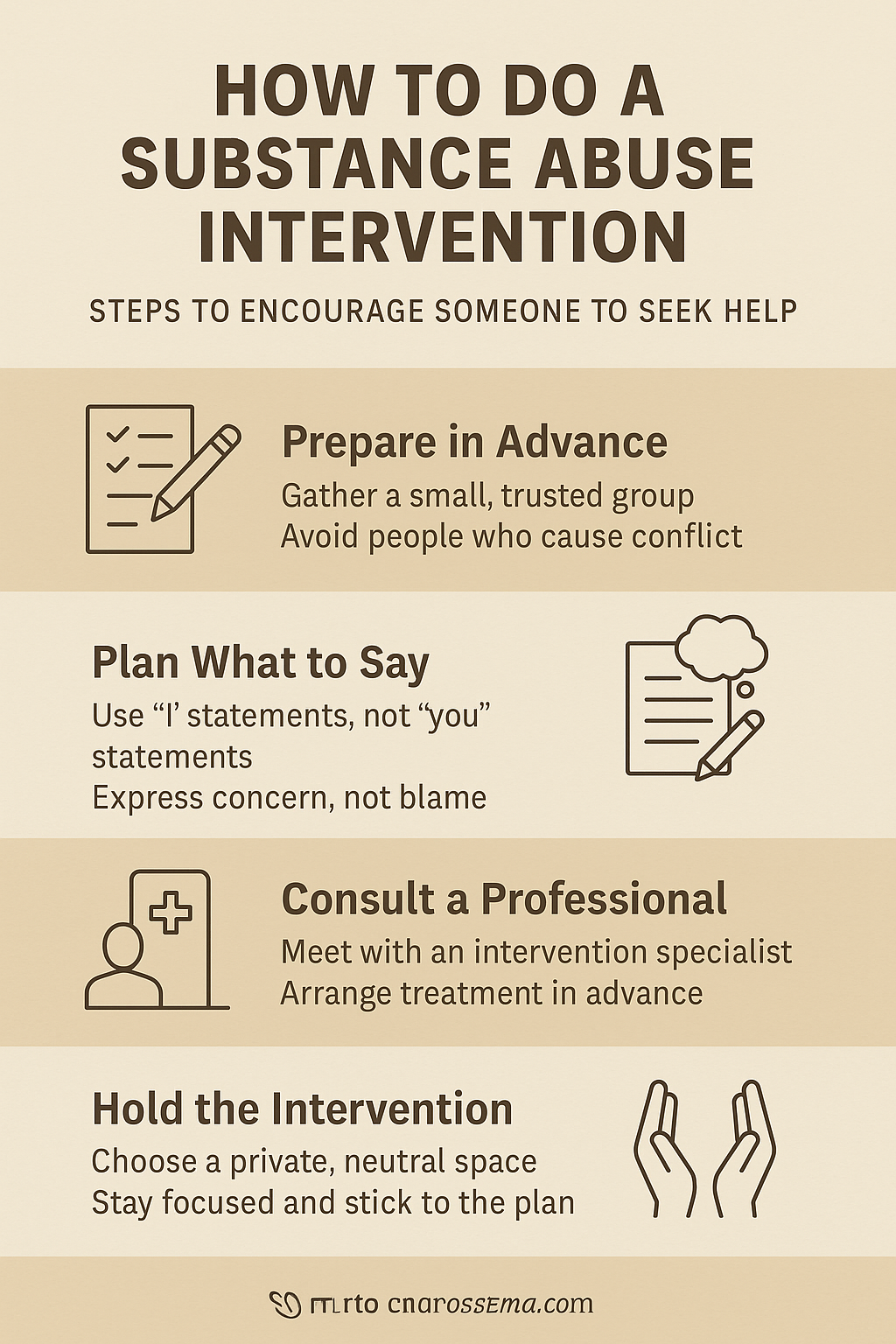
Substance abuse can have a profound impact on individuals and their communities. When someone struggles with substance use, an intervention can be a compassionate step toward recovery. Although addressing such issues may seem challenging, careful planning and a clear understanding of the process can facilitate a meaningful conversation. In many situations, the cycle of addiction creates isolation and despair, yet a well-thought-out intervention offers a path toward renewed hope and healing.
Many families and friends feel uncertain about when and how to intervene. Instead of assigning blame, an intervention is about offering heartfelt support and creating an opportunity to reconsider behavior that could be harmful. Setting the stage with sensitive planning fosters an environment of safety, understanding, and mutual respect conducive to recovery. This approach not only benefits the individual in crisis but also helps mend relationships that may have been affected by the turmoil of addiction.
The following guide explains an all-in-one, step-by-step approach for planning and executing a substance abuse intervention. Whether you are a concerned friend, family member, or community member motivated to help someone in need, these strategies provide a structured outline for creating a respectful and effective intervention process. With detailed preparation and supportive dialogue, every participant can help make this critical moment a turning point in the journey toward recovery.
Step 1: Assess the Situation and Define Goals
Before organizing an intervention, it is essential to thoroughly examine the situation and understand the underlying dynamics. Reflecting on the specific circumstances helps you clearly define your objectives. The intervention should have goals that may include encouraging the person to seek professional help, reducing risky behaviors, or simply opening a calm dialogue about their well-being. This critical first step sets the tone for every subsequent action.
Begin by assessing the overall impact of substance use on the individual and those affected by it. Ask yourself tough but honest questions, such as: How has substance use affected our relationship? What behaviors clearly indicate that there is a problem? What realistic outcomes can I expect from this intervention? If there are any immediate safety concerns for the person or others around them, these must be identified and prioritized.
This thoughtful analysis serves as the backbone of your intervention plan, helping to assemble the necessary support network. The entire process becomes more focused and effective when every participant understands the objectives, from urging professional help to initiating a long-term recovery plan.
Step 2: Gather Knowledge and Resources
Arm yourself with as much information as possible about substance abuse and the intervention process. Informed decisions help dispel myths and reduce the emotional biases that often cloud judgment during such trying times. Understanding the behavior patterns and underlying causes of addiction can also support a compassionate, nonjudgmental approach that centers on recovery rather than criticism.
How can you build a robust base of knowledge? Start by researching credible sources on substance abuse and recovery techniques. Look up publications and reports from recognized health organizations and treatment centers, and make a point of reading books or attending seminars that delve into the nuances of addiction and intervention strategies. Supplement this information by gathering details about the various treatment options available in your locality.
Additionally, compile a list of indispensable resources during the intervention. This might include information sheets on treatment programs, contact details for local rehabilitation services, and recommendations for professional counseling. By gathering community resources and expert advice, you enhance your preparedness and confidence, ensuring that you can effectively address any questions or concerns that may arise during the discussion.
Step 3: Plan the Intervention Meeting
Creating a clear and structured plan for your intervention meeting is crucial to maintaining a calm, focused, and productive conversation. A meticulously planned meeting can help reduce anxiety for you and the individual facing these challenges. It also ensures that important topics are addressed systematically without the conversation straying too far off track.
When planning the meeting, think over every detail. Choose a neutral location that feels safe and private, with minimal distractions. Select a time when the individual is most likely to be calm and free from other urgent commitments. Preparing a script or a list of key points can also help maintain focus, ensuring that every essential topic is covered. Furthermore, involve supportive allies, such as close family members or trusted friends, who can bring stability and reassurance to the gathering.
This careful planning helps prevent misunderstandings and reduces the risk that the meeting will turn confrontational. Each participant is assigned a role, and together, everyone can contribute calmly and constructively to guide the conversation toward solutions and recovery.
Step 4: Create a Supportive Environment
The intervention’s physical and emotional setting plays a significant role in its success. A warm, secure environment can help lower a person’s defenses and make them more receptive to hearing genuine concern. It is essential to create a space free of distractions and judgment, where sincere care is evident in every detail.
Ensure the meeting space is private and comfortable to foster a positive environment. Arrange seating so that every participant is equal, and avoid any configuration that might suggest a hierarchy or dominance. Turn off mobile devices and other potential distractions to maintain focus on the conversation at hand. Establish and agree on some ground rules—such as speaking calmly and listening attentively—before the meeting begins to ensure the discussion remains respectful and productive.
The extra effort invested in creating this safe space helps demonstrate to the individual that the meeting is about support and care, not about criticism or control. This is often a catalyst for opening up, as even a tiny change in the environment can significantly influence the intervention’s outcome.
Step 5: Seek Professional Guidance
In any intervention, involving professional help can be a game-changer. Specialists, such as addiction counselors and intervention experts, bring a wealth of experience that can transform a potentially tense conversation into a constructive and hopeful one. Their objective perspective can be very reassuring and help everyone involved stay focused on recovery.
Determine the right moment to include experts in your plan. Consult a professional interventionist who can help map out the process and may be willing to moderate the meeting. Research local treatment centers and counseling providers, and ensure you have their contact information ready, especially if the situation requires immediate professional support. By involving a professional, you add a layer of authority to the process and signal to the individual that there is a robust support framework behind them.
Professional guidance serves as a safety net and a catalyst for positive change. With experts on board, the person in crisis is more likely to feel reassured that help is available and that they are not alone in their struggle. This partnership is vital in steering the conversation toward long-term recovery rather than a temporary fix.
Step 6: Communicate with Empathy and Clarity
At the heart of any successful intervention lies effective communication. The aim is to express concern sincerely and clearly without making the individual feel attacked. Using straightforward, empathetic language is crucial; it helps ensure that your message is received as coming from a place of genuine care rather than judgment or anger.
Employing ‘I’ statements is a valuable technique in these conversations. For instance, saying, “I feel worried about you,” shifts the focus from blame to personal concern. Additionally, discussing concrete examples rather than abstract criticisms helps ground the conversation in real-life experiences, making it easier for the individual to grasp the seriousness of the situation.
Remember to stay calm and maintain a friendly demeanor, even if the discussion becomes emotionally charged. If emotions run high, taking a break before resuming is perfectly acceptable. The goal is to ensure everyone feels heard and understood, keeping the dialogue focused on recovery. This twin focus on empathy and clarity can significantly enhance the intervention’s overall effectiveness.
Common Questions and Troubleshooting
It is natural to have questions and face potential roadblocks during an intervention. One common concern is what to do if the individual is in denial about their substance use. Denial can be a powerful force, but gentle, repeated expressions of care—supported by concrete examples—can help slowly break down these barriers.
Another frequent issue is handling strong emotional responses. It is essential to allow moments of silence so that the individual can process the information. Ensure that each participant speaks one at a time and affirms the feelings expressed, even if they are negative. If the conversation becomes too heated, do not hesitate to pause it and reconvene once everyone has had a chance to calm down.
Safety issues are a key concern during such interventions. If there is a risk of self-harm or aggression, have a predetermined plan, which might include contacting emergency services immediately. The well-being of all involved is the top priority, and clear protocols can help manage these challenging moments swiftly and effectively.
Final Thoughts and Next Steps
Planning a substance abuse intervention is a complex and demanding process, but it can be a crucial step for someone on the edge of recovery. This intervention is not a final solution; it merely opens the door to a future where professional help and personal determination can converge. Each step—from assessing the situation and defining clear goals to creating a nurturing environment—is pivotal in encouraging a path toward healing.
Take some time after the intervention to review what has been learned and solidify an actionable plan. Consider the following actions as a wrap-up to your process:
- Revisit your understanding of the situation and detail the outcomes you hope to achieve.
- Consolidate and review all gathered information and resources, ensuring that expert contacts and support groups are readily accessible.
- Plan future meetings or follow-up sessions, ideally with professional guidance, to ensure the conversation is structured after the initial intervention.
- Keep communication channels open and encourage the individual to seek help whenever needed. Reflect on every discussion to tweak and improve the strategy for ongoing support.
This action plan offers a realistic and caring approach to an inherently challenging situation. Every intervention is unique, and while setbacks may occur along the way, structured preparation combined with genuine care makes all the difference. Remember that every positive step counts on the long ride to recovery and that professional and personal support can gradually build toward lasting change. Think about how you can adapt these steps to create a supportive and genuinely transformative conversation for everyone involved.
Ultimately, the journey toward recovery is a shared experience. It is about lifting each other, making informed decisions, and moving forward with hope and resilience. The process is dynamic and demands commitment, patience, and, most importantly, love.
Video: How to Help a Loved One Beat Addiction
